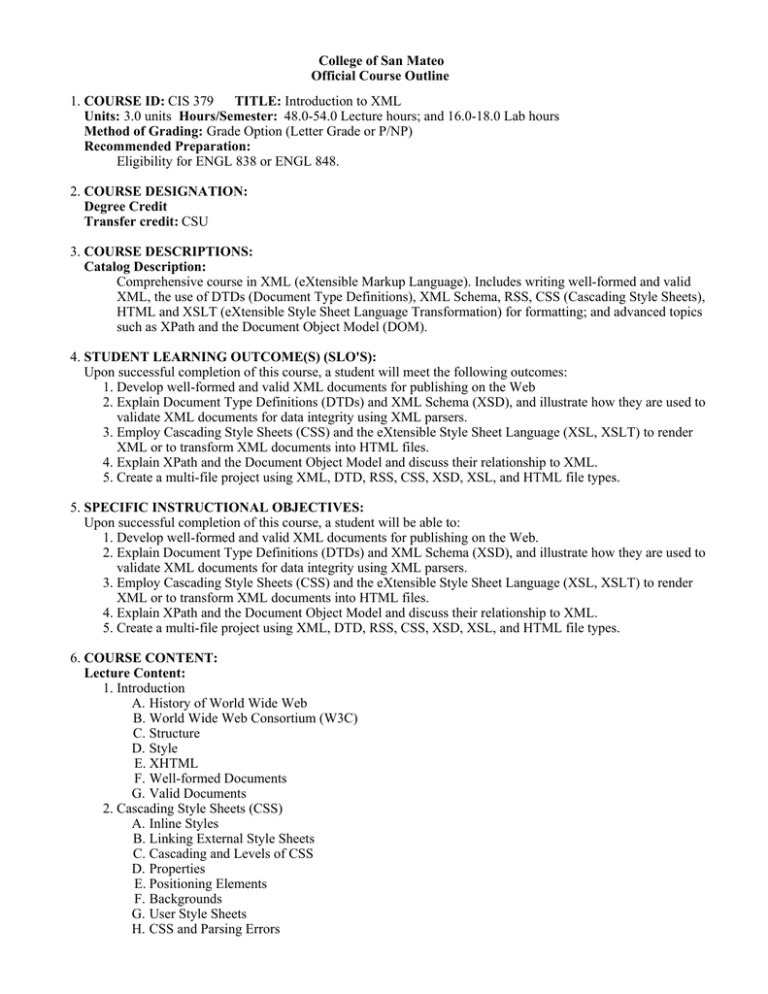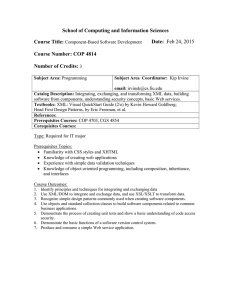College of San Mateo Official Course Outline COURSE ID: Units:
advertisement

College of San Mateo Official Course Outline 1. COURSE ID: CIS 379 TITLE: Introduction to XML Units: 3.0 units Hours/Semester: 48.0-54.0 Lecture hours; and 16.0-18.0 Lab hours Method of Grading: Grade Option (Letter Grade or P/NP) Recommended Preparation: Eligibility for ENGL 838 or ENGL 848. 2. COURSE DESIGNATION: Degree Credit Transfer credit: CSU 3. COURSE DESCRIPTIONS: Catalog Description: Comprehensive course in XML (eXtensible Markup Language). Includes writing well-formed and valid XML, the use of DTDs (Document Type Definitions), XML Schema, RSS, CSS (Cascading Style Sheets), HTML and XSLT (eXtensible Style Sheet Language Transformation) for formatting; and advanced topics such as XPath and the Document Object Model (DOM). 4. STUDENT LEARNING OUTCOME(S) (SLO'S): Upon successful completion of this course, a student will meet the following outcomes: 1. Develop well-formed and valid XML documents for publishing on the Web 2. Explain Document Type Definitions (DTDs) and XML Schema (XSD), and illustrate how they are used to validate XML documents for data integrity using XML parsers. 3. Employ Cascading Style Sheets (CSS) and the eXtensible Style Sheet Language (XSL, XSLT) to render XML or to transform XML documents into HTML files. 4. Explain XPath and the Document Object Model and discuss their relationship to XML. 5. Create a multi-file project using XML, DTD, RSS, CSS, XSD, XSL, and HTML file types. 5. SPECIFIC INSTRUCTIONAL OBJECTIVES: Upon successful completion of this course, a student will be able to: 1. Develop well-formed and valid XML documents for publishing on the Web. 2. Explain Document Type Definitions (DTDs) and XML Schema (XSD), and illustrate how they are used to validate XML documents for data integrity using XML parsers. 3. Employ Cascading Style Sheets (CSS) and the eXtensible Style Sheet Language (XSL, XSLT) to render XML or to transform XML documents into HTML files. 4. Explain XPath and the Document Object Model and discuss their relationship to XML. 5. Create a multi-file project using XML, DTD, RSS, CSS, XSD, XSL, and HTML file types. 6. COURSE CONTENT: Lecture Content: 1. Introduction A. History of World Wide Web B. World Wide Web Consortium (W3C) C. Structure D. Style E. XHTML F. Well-formed Documents G. Valid Documents 2. Cascading Style Sheets (CSS) A. Inline Styles B. Linking External Style Sheets C. Cascading and Levels of CSS D. Properties E. Positioning Elements F. Backgrounds G. User Style Sheets H. CSS and Parsing Errors 3. eXtensible Markup Language (XML) 3. eXtensible Markup Language (XML) A. Creating a Document B. Data a. Planning b. Developing c. Presenting C. Encoding D. Characters E. Markup F. Structures G. Parsers H. Modeling 4. Document Type Definition (DTD) A. Document Type Declarations B. Element Type Declarations C. Attribute Declarations D. Conditional Sections 5. XML Schemas A. Schema vs. DTDs B. Describing Elements and Attributes 6. Document Object Model (DOM) A. DOM Components B. DOMNodes C. Parsing and Loading D. XML Errors 7. eXtensible Style Sheet Language (XSL) A. Style Formatting using XSL B. Formatting Objects C. Lists 8. eXtensible Style Sheet Language Transformation (XSLT) A. Templates B. DOM vs. XSLT C. Xpath D. XSL T Elements E. XSL T Applications 9. Advanced Topics A. Server Technologies B. Relationship to Databases C. RSS Feeds D. Ajax Lab Content: Students will complete lab exercises and will create and work with XML data to reinforce the lecture material. 1. Create simple XML documents with elements and attributes. 2. Create namespaces for URLs, URIs and URNs 3. Create DTDs for an XML documents 4. Create XML Schemas 5. Create named model groups 6. Create simple and complex Schema types 7. Create a multi-document Schema 8. Create xPath variables and expressions 9. Create an XSLT template 10. Generate multiple result documents with an XSLT style sheet 11. Create user-defined functions 12. Use the Document Object and element nodes 7. REPRESENTATIVE METHODS OF INSTRUCTION: Typical methods of instruction may include: A. Lecture B. Lab C. Activity D. Directed Study E. Discussion F. Other (Specify): Lecture will be used to introduce new topics; Teacher will model problem-solving techniques; Class will solve a problem together, each person contributing a potential "next step"; Students will participate in short in-class projects (in teacher-organized small groups) to ensure that students experiment with the new topics in realistic problem settings; Teacher will invite questions AND ANSWERS from students, generating discussion about areas of misunderstanding; Teacher will create and manage an Internet conference for discussion of course topics; and students will work in small groups to solve programming assignments. 8. REPRESENTATIVE ASSIGNMENTS Representative assignments in this course may include, but are not limited to the following: Writing Assignments: Weekly assignments: textbook exercises and XML projects Reading Assignments: Weekly reading assignments from the textbook 9. REPRESENTATIVE METHODS OF EVALUATION Representative methods of evaluation may include: A. Class Participation B. Class Work C. Exams/Tests D. Homework E. Lab Activities F. Projects G. Quizzes H. Written examination I. Bi-weekly quizzes (short answer--from textbook material) to provide feedback to students and teacher; Assessment of student contributions during class discussion and project time; Individual programming assignment; Midterm and Final exams (short answer (textbook material), general problem solving (similar to in-class work), short program segments (similar to programming assignments); Assessment of group participation on course projects, including peer-assessment of participation and contribution to the group effort. 10. REPRESENTATIVE TEXT(S): Possible textbooks include: A. Walmsley. Definitive XML Schema, 2nd ed. Prentice Hall, 2012 B. Stanek. XML, DTDs, Schemas: The Personal Trainer, 1st ed. CreateSpace Independent Publishing Platform, 2014 C. Fawcett, Ayers & Quin. Beginning XML, 5th ed. Wrox, 2012 D. Carey & Kelley. New Perspectives on XML, Comprehensive, 3rd ed. Cengage Learning, 2014 Origination Date: September 2014 Curriculum Committee Approval Date: November 2014 Effective Term: Fall 2015 Course Originator: Melissa Green






